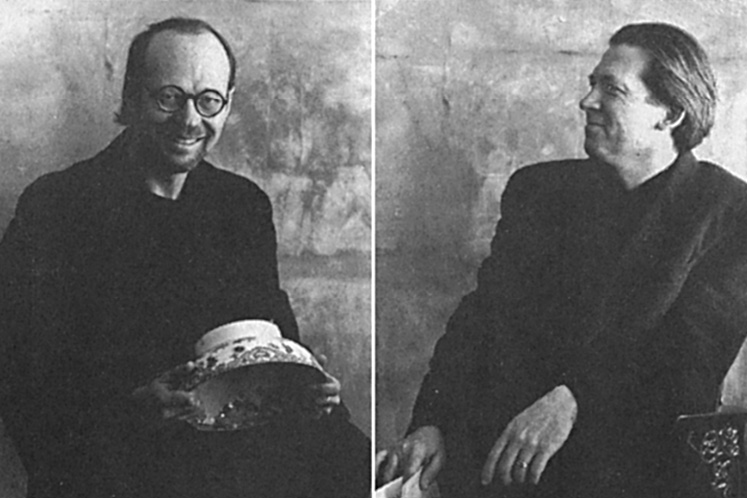Dufferin’s Cultural Impresarios
From the archives: Our first issue in 1994 profiled the driving forces behind two exceptional new cultural institutions: Wayne Townsend, curator of Dufferin County Museum and Archives (as it was then known) and Jim Betts, artistic director of Theatre Orangeville.
Two major cultural institutions will open in Dufferin County this year. Both the Orangeville Opera House and Dufferin County Museum have been boldly conceived on a visionary scale. They will serve not only as exciting new community resources but as highly visible tourist destinations, aiming to attract thousands of visitors from outside the area each year.
Charged with bringing the projects to fruition are two men: Wayne Townsend, the museum’s curator, and Jim Betts, artistic director of Theatre Orangeville. Working with one staff person each, but supported by a host of volunteers and enthusiastic municipal councils, the two men are getting set to launch what many predict will be a twin-engine kick-start to the cultural and economic revitalization of Orangeville and Dufferin County.
Wayne Townsend – Curator of Dufferin County Museum
Once every month or two, Wayne Townsend visits the Avalon Retirement Centre to lead a program for Alzheimer patients. It is no small coincidence that a man whose career and avocation is to preserve the community’s collective memory is drawn to the service of those whose personal memory is fading. He is moved as much by the profound tragedy of lost memory as by the remnants of utter clarity which remain. In his pursuits, he is a soulmate to those in the group. Like them, he struggles daily to uncover, preserve and make sense of fragments from the past.
Wayne Townsend is a native son, born into the family of one of area’s original settlers. He grew up on a mixed farm in the tiny hamlet of Monticello in East Luther. After leaving high school, he got his first “real” job as a packing boy at Drummond Business Forms in Orangeville. He spent 18 years there, working his way into management as supervisor of the graphic arts department. Along the way he got in a lot of travelling, worked in a restaurant, then opened his own – the locally famous Paradise, which had a sparkling and unconventional five-year stint on First Street. He also pursued his passion for rural history, becoming an obsessive and knowledgeable collector and, as chair of the Local Architectural Conservation Advisory Committee, an inveterate thorn in the side of anyone who dared to tamper with local historic sites. Although that interest was consuming, there was nothing obvious about the direction it was leading. Managing a multi-million dollar museum hadn’t figure in Wayne’s career plans, until fate intervened.
“It happens around age 40, I guess,” Wayne says. “You can do all these things that aren’t related. Then suddenly they all start to fit together into something useful … thank god. I did wonder if there was a purpose to all this.”
Growing up in rural Dufferin, Wayne experienced a rural life that many of the area’s newcomers associate with more distant history. Modern conveniences came late to rural communities like East Luther. Wayne recollects, “I was in Grade 7 before we got hydro, Grade 8 before we got indoor plumbing, and I don’t consider myself all that old.”
He recalls the eventful Friday night trips from Monticello to Orangeville with his parents in the ’50s, when the stores stayed open until midnight to give the farmers time to finish their chores before they came into town to shop for the week.
“When you were done your shopping, you’d sit in your car on the street and watch people go by. If Dad and Mum knew anyone, they’d get out and talk to them. Everyone did that, so it became my idea of becoming successful. I wanted to grow up and move to Orangeville. There were garages, there was a show …” Wayne did move to Orangeville, boarded there while he attended high school, and stayed. He laughs, “It’s nice to be able to achieve your dreams in your own lifetime.”
For all his respect for the past, Wayne has no quarrel with the present. Asked what period he would describe as Dufferin’s golden age, he doesn’t hesitate a beat in pronouncing, “1994.”
Why? As much as anything, because of the new people. “I love the new people,” Wayne says. “They’re interested; they don’t take for granted what we take for granted having lived here forever … the hills, the rivers, the lifestyle.” They bring a fresh perspective, and because they have made an active choice to come here, “they are willing to work hard to make the community a good one.”
Although Wayne is at home in the past – he regularly bounces cheques by dating them 1894 – he brings a very contemporary sensibility to his task. He breaks ranks from the traditional museum community, for example, with his determination to make the museum a successful business. He enjoyed the challenge of running his own business and honed his management abilities at Drummond. He speaks gratefully of the active opportunities the company gave him to develop both financial and staff management skills.
“I like business. I like making money. That’s the thing about the museum, it’s a real challenge to make money.” The museum has received more than $4 million in startup funding from three levels of government. Wayne’s goal is to have the museum generating half its annual operating costs within five years, through gate receipts, program fees, licensing agreements, ground rentals and other activities.
“As family entertainment, we’re competing with the likes of Canada’s Wonderland,” he says. That’s why he has not only studied other museums, developing a list of dos and don’ts from listening and talking to curators in virtually every community museum in Ontario, but he’s also considered the success formula for such diverse places as Disneyland and the Edmonton Mall. This has translated into a marketing campaign that is aggressive by most community museum standards, as well as the inclusion of interactive displays and performance space incorporated into the main exhibit area.
The late 20th century intercedes on behalf of history in another way as well. Staff and volunteers have been busy computerizing the archival records. For the user, the computerized archives permit a vastly streamlined information search. If someone wanted to reconstruct the history of a family member, for example, they would key in the name and pull up a directory listing any related artifact in the museum’s collection, any photo, any newspaper mention back to 1860, or any other documented reference. In turn, each of these would invite the researcher down another electronic sideroad to the past.
But the most important symbol of this contemporary approach to heritage restoration is the brand new building itself. The huge green and red barn-like structure rises on a foundation of stones gathered from the fields of Dufferin. The 60-foot silo dominates the landscape at the corner of Airport Road and Highway 89, commanding a spectacular view of the hills and valleys of Mulmur and Mono.
Within the 26,000-square-foot museum is an exhibition space large enough to comfortably house three small historic buildings: a small flagging station with the names of waiting travellers still visible where they were etched with pen knives on the wall; a two-storey log house; and another log structure that served variously as the Orange Lodge, a school and a church.
The site and structure were selected amid some controversy. The first choice of many was the magnificent old schoolhouse in Shelburne, mostly recently used as an arts and cultural centre. Like many, Wayne feels real affection for the old school building. The difficulty, as he and others saw it, was the endless compromises that would be necessary to force the new museum, with its all its needs in terms of storage, climate control, space for large groups and growth potential, into a structure designed for something else. After heated community debate, the new site was given the nod. Wayne was delighted: “Community museums usually get stuck in historic buildings. That was one of the biggest problems I heard about when I visited other museums. So now we’ve turned it around. We’ve fit historic buildings into our museum.”
The museum opens in September. For Wayne, it has been less a case of finding his calling than of his calling finding him. He’s been in the right place all his life. Come September, it will be the right time.
Jim Betts – Artistic Director of Theatre Orangeville
For Jim Betts, the place may not have been predictable, but the job certainly was. Jim has spent all his adult life performing, writing and composing for theatre. And the seeds of that career were sown early. Jim grew up in Mississauga – still a long way from Toronto in the ’50s, but already within the urban shadow. Raised in a musical family, Jim was an accomplished young violinist – a discipline he now credits with giving him his sense of melody. When he hit adolescence, the predictable teenage angst found expression in song writing. “I must have written a hundred songs before I left high school,” he says, and adds with a laugh, “They were terrible songs – love songs, protest songs, Beatlestype songs – whatever anybody else was writing, I wrote.”
As an English student at the University of Toronto’s Victoria College, he fell in with a group of like-minded musicians in the Vic Music Club. With them, he wrote and performed “Broadway-style” musicals at Hart House. In his final year, they performed at the Muskoka Sands Hotel where they were spotted by a producer from CBC’s Tommy Hunter Show. The gold-medal student put his post-graduate plans on hold to become a backup singer and dancer on Canada’s favourite country variety show. He did go back and complete his master degree, but the die had been fully cast. He assumes the role of director of his own theatre company after a 20-year career that includes 10 years as a performer and well more than two dozen writing credits for musical theatre and plays for stage and television. Along the way he also has picked up a fistful of distinguished drama awards.
The stage was set for Theatre Orangeville less than 18 months ago, when the provincial government suddenly approved a grant application to restore the Orangeville Opera House. Built in 1875 and once a lively fixture on Broadway, the opera house, on the second floor of the Orangeville municipal building, had fallen into disuse in the sixties and was taken over as meeting space for the board of education. As the building fell into further disrepair, the municipal offices moved out. The historic building stood empty, virtually condemned as the restoration application languished in ministry files.
In the interval, Jim Betts had joined the Orangeville library board. He had moved with his young family from downtown Toronto to Alton about seven years ago. When his two daughters became old enough to ride bikes, the family moved to Orangeville. It offered the girls not only a paved riding surface but ready access to school and friends. Ready to get more involved in community life, Jim thought the library board might be a good place to start. He was right.
“The library board sounds like it would be a pretty tame place, but it’s not,” Jim says. He quickly became chair of the board and led the library through a period of significant restructuring. “From then on I was travelling in a completely different circle. I suddenly had access to the people who make decisions here.”
He had heard about the Opera House application and used every opportunity to query Mayor Mary Rose and other decision-makers about what would happen if the restoration application were ever approved. He was concerned that without forethought, the building would become “a gigantic, multimillion-dollar white elephant that nobody every uses.” According to Jim, “They got tired of me saying that and finally asked, ‘What do you suggest?’ So I wrote up a proposal.”
He presented his proposal to a group of community leaders gathered together by Pat Moyle, Orangeville’s chief executive officer. He described a professional company that would present family-oriented theatrical and musical entertainment in a summer festival format. There would be special emphasis not only on plays for children and youth, but on programs designed to encourage young people in the community to develop skills in a variety of disciplines, including acting, writing and theatre management. The community at large would be encouraged to participate in workshops, monthly play readings, and the development of a community play based on the history, legends and people of the area.
“They listened to me very politely and said, ‘How much will a feasibility study cost.’ So I quoted them a figure and right there, within 15 minutes, they’d raised the money and I was committed.”
By October 1993, the town had approved the plan and a community board, including the mayor herself, had been appointed. Community support has been forthcoming through a variety of fundraising activities, including a commitment by the Rotary Club to raise $60,000 through a seat endowment fund. On July 2, Theatre Orangeville will launch its first summer season with a gala evening of song and dance. The season’s first play, The Drunkard, a Victorian melodrama by William H. Smith, opens the following night. It has all transpired with head-spinning speed – the kind of speed only possible when an individual with talent and focus is backed by a community with desire and vision.
It’s a winning combination, says Barry Dimock, a Caledon resident and retired professional theatre administrator. He worked with Laurence Olivier to found the Chichester Festival Theatre in England and with Mavor Moore to found the St. Lawrence Centre for the Arts in Toronto. The startup of both those theatres would have been far less painful if they’d had the kind of political support that Jim Betts and Theatre Orangeville seem so far to enjoy, Dimock says. “I have gradually got to know Jim Betts and I have gained tremendous respect for his talent … The town should really be commended, first for restoring the building and then having the good sense to take the next step and put a heart inside it.”
Orangeville’s motivation these days is palpable. Once the centre of commercial activity for the area, the town, for a variety of reasons, hasn’t managed to keep pace with changing consumer demands in the surrounding countryside. According to one Orangeville developer, “A lot of people from the area – people with significant disposable income – haven’t had a reason to come to Orangeville for a long time.” Jeff Child decided to develop the Victorian Village Mews, an indoor boutique mall near the Opera House, largely on his faith that Theatre Orangeville will mark “the dawn of a whole new era for downtown Orangeville.”
His hopes will be well placed if the theatre is successful in its plan to attract between 12,000 and 15,000 visitors this season. The diverse program gives it a good shot at that target.
The first play, The Drunkard, is a story of love and redemption. A popular melodrama from the turn of the century, it was chosen as a fitting tribute to the history of the restored Opera House. It will be followed by The Mystery of the Oak Island Treasure, one of six plays Jim Betts wrote for Young People’s Theatre in Toronto; A Fairy’s Tale by Leslie Arden, a musical version of a Charles Perrault story, suitable for adults and children alike; and Letter from Wingfield Farm, a play that grew out of author Dan Needles experiences in Dufferin County and which has had a highly successful run across the country. Also on the summer’s program is Murmel, Mermel, Mortimer, Munsch, a Young Company production of one-act stories by Robert Munsch, adapted for stage by Kim Selody.
No one expects the theatre to transform downtown Orangeville singlehandedly, least of all Jim Betts. But, he says, “it can bring a significant amount of money into the community over the long term and start bringing people into the downtown who haven’t been there before.” And that, most agree, would a good thing.
Related Stories

In Retrospect – Autumn 2023
Sep 8, 2023 | | ArtsA look back on how we’ve covered the pleasures and concerns of country life over the last three decades.









